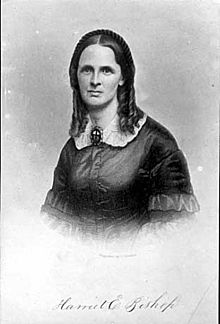Harriet Bishop facts for kids
Quick facts for kids
Harriet Bishop
|
|
|---|---|
 |
|
| Born | Harriet Bishop January 1, 1817 Panton, Vermont, United States |
| Died | August 8, 1883 (aged 66) Saint Paul, Minnesota, U.S. |
| Pen name | Harriet E. Bishop McConkey |
| Occupation | Teacher, writer, activist |
| Alma mater | New York State Normal School |
| Genre | Naturalism, History |
| Subject | Minnesota |
| Notable works | Floral Home Dakota War Whoop Minnesota Then and Now |
| Spouse | John McConkey (divorced) |
| Relatives | Eunice Gibbs Allyn |
Harriet E. Bishop (January 1, 1817 – August 8, 1883) was an American educator, writer, suffragist, and temperance activist. Born in Panton, Vermont, she moved to Saint Paul, Minnesota in 1847. There, she started the first public school as well as the first Sunday school in Minnesota Territory. She was a founding member of temperance, suffrage and civic organizations, and played a central role in establishing the First Baptist Church of Saint Paul. An active promoter of her adopted state, she was the author of books such as Floral Home, or First Years of Minnesota (1857) and Dakota War Whoop, or Indian Massacres and War in Minnesota of 1862–63 (1863).
Harriet Island, now part of the Mississippi shoreline near downtown Saint Paul, was named after Bishop.
Education and career
Bishop received her teacher training at the Fort Edward Institute, and the New York State Normal School in Albany, New York under the instruction of renowned educator Catherine Beecher of Boston, Massachusetts. She spent about the first decade of her career teaching in Essex, New York.
Given the growing demand for teachers on the expanding frontier, and the limited number of opportunities in New England for young women to find teaching positions, the newly formed Board of National Popular Education in Cleveland, Ohio developed a program that encouraged young women teachers to move to the western territories to found schools. When news came of an opportunity in the Minnesota Territory, Bishop was eager to pursue it as an exciting adventure. Of the protests and arguments her family and friends made against her decision, she later wrote that they "were to me as so many incentives for me to persist in my decision." Her inspiration for adventure was partly influenced by reading the memoirs of Baptist missionaries Harriet Newell and Ann Judson during their missions in Burma.
The first school house, which she opened in a former blacksmith shop on July 19, 1847, was a "mud walled log hovel... covered with bark and chinked with mud" at what is now St. Peter Street and Kellogg Boulevard in the relatively isolated fur trading post of Saint Paul. Within less than a year, she organized the Saint Paul Circle of Industry to raise funds to build a new structure for the students. The new building also served as a church, meeting hall, courtroom, and polling place. Of the seven students in her first class, only two were caucasian. She had to rely on a student who was fluent in French, Dakota, and English to translate for her classes (which she taught in English). To further aid in the education of Minnesota children, Bishop established the Minnesota Women's Seminary in Saint Paul in 1850.
Fitting with her deep religious faith and devotion, shortly after her arrival, she also founded first Sunday school in Minnesota. Bishop is considered the de facto founder of the ecumenical church movement in Minnesota.
Activism
Bishop was actively involved in many public concerns, most notably the temperance movement and women's suffrage. She helped organize the Sons of Temperance. In 1867 she helped found the Ladies Christian Union and spearhead the construction of the Home to the Friendless, which is now Wilder Residence East. In 1877, she became the first organizer of the Minnesota Women's Christian Temperance Union, working to help form chapters all over the state. Bishop is also recognized as one of the founders of the Minnesota Woman Suffrage Association.
Personal life
There is little information about Bishop's private life. She was the third daughter of Putnam and Miranda Bishop of Panton, Vermont. She was engaged to marry a young Saint Paul lawyer who was younger than her, but the engagement was called off by the man's sister who believed the age difference between the two to be improper. In 1858 she married John McConkey, a widower with four children. This marriage lasted until 1867.
In the early 1870s, Bishop was a defendant in a civil suit charging that she had made unauthorized land purchases on behalf of a New York land speculator. Shortly after this, in 1873, she went on a lecture circuit in California. She returned to Saint Paul in 1875 where she continued to work as a lecturer, writer and activist until her death on August 8, 1883. She is buried at Saint Paul's Oakland Cemetery.
Partial list of works
- Floral Home; or, First Years of Minnesota, published in New York, 1857
- Dakota War Whoop, or Indian Massacres and War in Minnesota of 1862–63, published in 1863
- Minnesota Then and Now, published in 1869
Legacy
Harriet Island, now part of the Harriet Island Regional Park in Saint Paul, was named after Harriet Bishop.
Bishop is the namesake of the Harriet Bishop, a riverboat operating out of Saint Paul. Harriet Bishop Elementary School in Rochester, Minnesota and in Savage, Minnesota are also named for her.
See also
 In Spanish: Harriet Bishop para niños
In Spanish: Harriet Bishop para niños

